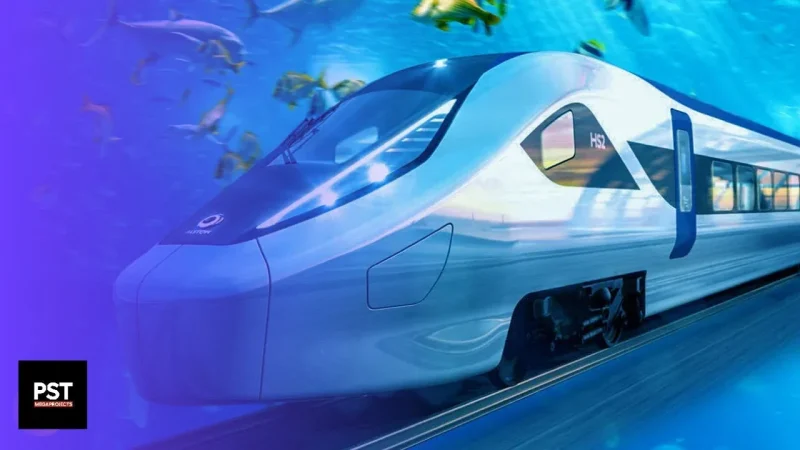With so many different railways worldwide, you’d think we’ve created the most advanced railways, but if history taught us anything, it’s that there’s always something new right around the corner. Overwater trains are relatively common but underwater trains definitely are not. Imagine taking a train that glides through crystal-clear waters, with a stunning view of marine life as you travel at extremely high speeds to your destination; this is exactly the UAE’s newest, groundbreaking vision.
In its newest and arguably most ambitious venture, the UAE plans to cross the Arabian Sea, connecting its port city of Fujairah, with India’s financial capital, Mumbai, through a daring underwater train.
Project’s Origins
The idea for a railway tunnel linking Fujairah and Mumbai was first presented by Abdulla Al Shehhi, the managing director and chief consultant of the consultancy company the National Advisor Bureau Limited, in 2018 during the India-UAE Conclave that was held in Abu Dhabi.
He explained that the concept is to connect Fujairah with Mumbai via high-speed floating trains. With this project, the UAE hopes to bridge the gaps between the two cities and provide the region with an innovative method of transportation.
You might think this idea sounds unrealistic, but the National Advisor Bureau Limited is actually working on a feasible blueprint for the railway and the type of trains that will be required to make this project a reality.
Benefits
The project’s main benefit will be reducing the travel time between the UAE and India, which is currently slightly over three hours by air. This does not include the pre-flying formalities at the airport. By switching to an underwater train, the UAE hopes to cut that time by at least one hour. A train can travel at speeds as high as 1,000 kilometers, or 600 miles, per hour.
To give you an idea of how fast this would be, you should know that the fastest train in the world, the Shanghai Maglev in China, travels at a maximum speed of 460 kilometers per hour, or approximately 286 miles per hour. Therefore, this speed that the UAE is proposing is just unbelievable.
Whether it’ll be able to achieve this speed or not, the project would still provide massive benefits to the citizens of the two countries. As of January 2024, the Indian population in the UAE is 3.89 million, and the UAE was the leading destination for Indian tourists in 2022, attracting 5.89 million visitors in that year.
These people would definitely appreciate an easier method of transportation between the two countries. But, this project is not meant to serve only passengers who are averse to taking the air routes.
In fact, the UAE is largely looking at it as a means to expand bilateral trade with India. It expects Fujairah’s port city to export oil and gas to India, while India exports fresh water from the Narmada River to the UAE.
Construction
By now, you must be wondering how this project will be constructed. Will it really be built on train tracks on the ocean floor, hundreds of miles between Fujairah and Mumbai?
Of course not. The actual plan is to install two massive curved tubes in the Arabian Sea. These tubes will float on the water and be fully watertight to eliminate any chance of water erosion or any other kind of damage on the inside that can be caused by the water.
Then, these tubes will be attached to various industrial-scale pontoons for stabilization. Another set of two tubes, supported by each of the previously mentioned tubes, will house just one rail line so trains can travel from both directions.
In addition, the tubes will include multiple pipelines that will help import and export oil, gas, and water. The National Advisor Bureau Limited also suggested that the tubes be made of see-through glass to provide commuters with views of the sea and passing marine life.
The type of train that will be used will be determined through a feasibility study, but we don’t know when it will begin. What we do know is how the trains will operate.
The underwater trains will operate in a vacuum within the tubes to reduce air resistance. They will also use Maglev technology, which implements two sets of electromagnets in the construction of the railway: one to lift the train off the track to give it a floating effect, and the other to push the train forward.
This technology provides trains with an almost frictionless ride to trains on land, allowing trains that use it to reach 300 miles per hour or more. You could say that by combining Maglev technology with reduced air resistance, then the Fujairah-Mumbai railway might have a chance at reaching the impossible speed of 600 miles per hour.
Then again, all of this is entirely theoretical, and whether an underwater bullet train can be achieved is yet to be seen.
Is it Feasible?
For starters, there are other projects like this one, so it isn’t impossible to pull off. The Channel Tunnel, which links the United Kingdom and France through an undersea railway has been functional since 1994.
However, the difference between the two projects is that the Fujairah-Mumbai railway will offer a visual experience using see-through manufacturing materials. In contrast, the Channel Tunnel only offers the view of brick and metallic walls. This could alone be the project’s selling point, and people from all over the world would probably come to Mumbai or Fujairah just to ride this train.
Another huge difference between the two projects are their sizes. The Channel Tunnel between the United Kingdom and France is merely 56 kilometers, or 35 miles, long. Additionally, its trains run at a relatively slow speed of 112 kilometers, or 70 miles, per hour.
The Fujairah-Mumbai railway plans are much more ambitious in comparison. The distance between the two cities is around 50 times longer than the distance between the United Kingdom and France, and the speed is also around ten times faster.
There’s also the challenge of achieving the view . If you’ve ever been on a bullet train, you’d know how blurry the view from the window could get as the train travels faster. Personally, I’d be very disappointed if I was promised stunning views of the sea and ended up seeing a blurry mess.
Another risk is the tubes leaking, or getting damaged by natural factors like storms or underwater earthquakes. These risks have led some to wonder whether the underwater train project will ever see the light of day, while others have suggested it’s just the UAE’s way of stealing Saudi Arabia’s thunder.
The UAE’s Rivalry with Saudi Arabia
For so many years, the UAE was the Middle East’s top place for tourism, new technology, construction, and massive infrastructure projects. But now, Saudi Arabia is rising to challenge the UAE with its impressive megaprojects.
The biggest and most famous is the Line, a megacity extending horizontally and connecting the Saudi Arabian desert to the sea. Participating in the NEOM project is a very ambitious and expensive plan, which is expected to cost a total of $1 trillion.
This new competition in developments between the two countries turned them into frenemies. Even though the difference between the two countries’ GDPs is massive, with Saudi Arabia’s GDP being double that of the UAE, the UAE still received more foreign investment since 2013. In 2021, Saudi Arabia received $19 billion in foreign direct investment, while the UAE received $20 billion.
It’s clear that Saudi Arabia isn’t satisfied with the current status quo between the two countries, and desires to change it by building impressive megaprojects of its own. We can confidently say that NEOM is the most talked about development in the entire world.
What could possibly take the attention of NEOM? An underwater bullet train linking two different countries, especially if it gets completed before NEOM does. If the UAE is planning to one-up Saudi Arabia, then it needs to act quickly, as NEOM’s construction is already underway and planned to be completed sometime around 2030.
Notably, Mumbai is also going to be connected soon to another Indian city called Ahmedabad via a bullet train that will travel 21 kilometers underwater, so we can expect this type of train to be a increasingly common as time goes on.
Disclaimer
Please visit and read our disclaimer here.









